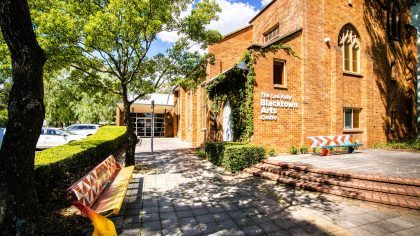Name/Titlegungun badumada
About this objectArtist statement
Coolamon
'Gungun means Coolamon in Darug language.
Gunguns are traditional tools used by Aboriginal people for a variety of
purposes, including carrying water and food, conducting smoking ceremonies, and cradling babies. When used for babies, soft materials such as paperbark and animal skins were often added as a lining to provide comfort during sleep.
'Traditionally, coolamons were carved from the trunks of trees using a stone axe. Hardwoods were preferred for their durability, as these materials produced solid coolamons that were less likely to split or break. The technique used to extract the coolamon was carefully designed to avoid harming the tree. This method ensured that the tree would continue to thrive after the coolamon was taken, with no long-term damage. Over time, as the tree healed, an oval-shaped scar would form on the bark, marking the spot where the coolamon had been removed.
'These scar trees, though rare, can still be found today. One notable location where these historic trees can be observed is Parramatta Park, where the scars of coolamons, carved centuries ago, remain visible for the public to appreciate.
Gungun Badumada Story
'The word gungun, in the Darug language, translates to 'coolamon', a traditional vessel of great cultural significance. This particular gungun was carved using a stone axe from the wood of a grey gum eucalyptus tree, located in the Bago State Forest in New South Wales.
'The tree holds deep meaning for the Goldspink/Reid family, the Traditional
'Owners of Parramatta, who trace their ancestral roots back to Western Sydney – Dharug Land. The tree stands beside an unmarked grave, a solemn reminder of one of the Baramadagal ancestors from the Goldspink family. This grave, like so many others, speaks to the painful history of displacement and forced removal that Aboriginal families, including the Goldspinks, endured as a result of past government policies.
'Despite these displacements, the Goldspink family found their way back to their country, reclaiming their connection to the land. This gungun embodies that journey of return. It is a powerful symbol of the resilience and strength of Aboriginal people, a testament to the enduring bond between them and their land. Though they may be separated from their traditional lands, the land - country - will always await their return, and in their return, the country will heal.
'The gungun stands as a reminder that no matter how far one is taken from home, the spirit of the land remains steadfast, always calling them back to where they truly belong.
'Hand carved into the gungun is the Baramadda River (Parramatta River). gungun badumada translates to water holding coolamon in English.'
Tara Lloyd is a proud Baramadagal-Wiradjuri artist and cultural practitioner committed to sharing and celebrating the richness of Aboriginal culture through art and weaving.
Her work has been recognised on a national level, including being a finalist in the 2024 Omnia Art Awards for Aboriginal weaving, and the 2025 Blacktown City Art Prize.
Lloyd's commissioned artworks have been featured by prominent organisations such as ABC, Artefact Heritage, Catholic Education, and the Department of Education. She has collaborated with Aspect Design Studios and Tilt Industrial Designs, providing cultural advice on the Central Park Development in the new Western Sydney suburb of Bradfield. She advised on the design of the Interwoven Heart Park, where her traditional Aboriginal weaving is incorporated into the Park’s shelters.
In addition to creating custom woven wall artworks and digital designs for public art, jerseys, and signage, Lloyd runs a cultural consultancy business. She specialises in providing cultural advice on development projects, ensuring alignment with Designing with Country frameworks, and delivering cultural responsibility training for organisations seeking to engage meaningfully with First Nations culture.
Passionate about weaving cultural knowledge into contemporary contexts, Lloyd strives to create artworks and initiatives that honour and amplify the voices of her community.
MakerLloyd, Tara
Maker RoleArtist
Date Made2024
Medium and MaterialsHand-carved wood (Eucalyptus punctata)
Place MadeBlacktown
Place NotesDharug Country
TechniqueCarved
Measurements11 h x 11 w x 64 cm l x wt 2kg
Subject and Association KeywordsCultural object
Named CollectionBlacktown City Art Collection
Credit Line© Tara Lloyd
Acquired 2025, Blacktown City Art Prize exhibition
Blacktown City Art Collection
Photo: silversalt Photography
Object TypeCultural object
Object numberBCC LOD 001
